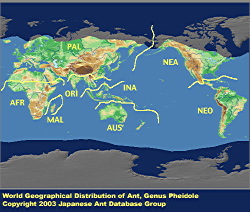
|
genus
|
Pheidole
|
 |
Japanese Name
|
Oozu-ari-zoku
|
Original Reference
|
|
Westwood, J.O. (1839) An Introduction to the Modern Classification of Insects; founded on the natural habits and corresponding organisation of the different families 2 (part 11): 193-224. London.
|
Description
|
|
Worker caste dimorphic. The major workers or "soldiers" have total body lengths of 2.5 - 6 mm and relatively very large heads; the minor workers or "workers" are 2 - 4 mm long with unexceptional heads. There are no caste intermediates in Japanese species. The three apical antennal segments form a club in both subcastes, and the pro- and mesonota are raised. In soldiers the anteroventral margin of the cranium carries one or two pairs of small gular denticles and a median projection. The pronota of some tropical species have distinct humeral projections or spines.
|
|

|
Remarks
|
|
This is one of the largest genera of the family Formicidae, including about 300 described species, with a likely total of more than 1000 species in nature. Pheidole ranges worldwide, and is particularly abundant in the tropics and subtropics. According to Wilson (1976) it is one of the three most prevalent world ant genera in terms of its geographic range, species diversity and local abundance (the other two genera are Camponotus and Crematogaster). Taxonomic coverage of the genus is far from complete. Regional revisions include: Brown (1981), Gregg (1958) and Naves (1985) for North American species; Kusnezov (1951) for South American species; and Ogata (1981, 1982) for Japanese species. Japanese species nest in the soil, under stones, in rotting logs and other rotting wood, and among the roots of plants. Those with the most populous colonies (e.g. P. noda and P. indica) sometimes form long-lasting foraging trails (Magata & Yamane, 1989). Foraging workers collect honeydew from aphids and honey from flowers, etc, for adult food, and solid food such as seeds and insects for the larvae. Division of labor is well-marked between the worker subcastes. The soldiers mainly dissect large food items within and outside the nest, and defend the colony and its surrounds (Yano & Yamane, 1990). In some species (e.g. P. fervida and P. ryukyuensis) the crops of soldiers are utilized for food storage (Tsuji, 1990c; Iida, pers. com.). Soldiers of the North American P. distoria are specialist seed-crushers (Wilson, 1984), though seeds are not a major food source in all Japanese species. The soldier/worker ratio is fairly consistent, with soldiers constituting around ten percent of whole-colony numbers. This ratio regulates worker production. Cast differentiation is said to relate to with juvenile hormone production during the larval stage (Ono, 1982). Solders and workers have no ovaries. The rearing of colonies is relatively easy (Iida, 1991). Eight species have been reported from Japan; one is not nomenclaturally identified.
|
References
|
|
- Wilson, E. O. (1976). Which are the most prevalent ant genera? . Studia Ent., 19, 187-200.
- Brown, W. L., Jr. (1981). Preliminary contribution toward a revision of ant genus Pheidole (Hymenoptera: Formicidae). Part I. . J. Kansas Ent. Soc., 54, 523-530.
- Gregg, R. E. (1958). Key to the species of Pheidole (Hymenoptera, Formicidae) in the United States. . J. N. Y. Ent. Soc., 66, 7-48.
- Naves, M. A. (1985). A monograph of the genus Pheidole in Florida (Hymenoptera: Formicidae). Insecta Mundi,, 1, 53-90.
- Kusnezov, N. (1951). El genero Pheidole en la Argentina. . Acta Zool. Lilloana, 12, 5-88.
- Ogata, K. (1981). Taxonomy and biology of the genus Pheidole of Japan. . Nature and Insects, 16(1), 17-22. .
- Ogata, K. (1982). Taxonomic study on the ant genus Pheidole Westwood of Japan, with a description of a new species (Hymenoptera, Formicidae). . Kontyu, 50, 189-197.
- Magata, K. & S. Yamane (1989). Recruitment pattern in a Japanese Myrmicinae ant, Pheidole indica (Hymenoptera, Formicidae). . Jpn. J. Ent. , 57, 448-458. .
- Tsuji, K. (1990c. ). Nutrient storage in the major workers of Pheidole ryukyuensis (Hymenoptera, Formicidae). . Appl. Ent. Zool., 25, 283-287.
- Wilson, E. O. (1984). The relation between caste ratios and division of labor in the ant genus Pheidole (Hymenoptera: Formicidae). . Behav. Ecol. Sociobiol., 16, 89-98.
|
Editor
|
|
Original text by Kazuo Ogata and Seiki Yamane. English translation by Kazuo Ogata, edited by Robert W. Taylor.
|
|